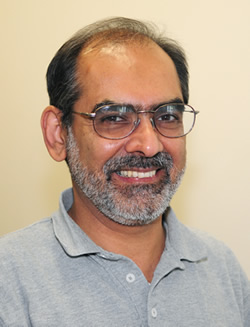Shedding Light on the Subject
Physics Professor Studies Wavelengths to Help NASA Explore Space
November 18, 2008
By Russ L. Hudson

Murtadha Khakoo
How does nitrogen in space behave when bombarded by electrons?
Knowing how it reacts in the atmospheres of planets and in interstellar gas clouds can help NASA explore space, and Cal State Fullerton physics professor Murtadha Khakoo is working on research to find out. The answer could help scientists study changes in Earth's atmosphere.
Khakoo is studying the wavelengths of photons, or particles of light, emitted by a N2 nitrogen molecule when struck by electrons. The different wavelengths reveal an atmosphere's density, as well as other atmospheric elements and the electrons' distance.
The N2 molecule was chosen because few other elements include all five properties needed for the study, said Khahoo.
“It is common in the universe, heavy enough to be pulled in by a planet's gravity, light enough to stay in the atmosphere, chemically stable so it doesn't easily combine with other elements and it squeezes out photons when an electron, or sometimes another atomic particle, hits it.”
The photons fly from the molecule as it returns to its basic energy state after being energized by an electron collision. “Voyager and the Explorer missions recorded this phenomenon,” Khakoo said. “They captured the spectral — that is, color — of the light emitted. Satellites with optical systems also can detect the wavelengths.”
The force of an electron's collision with an N2 and how easily the molecule releases photons determine the photons' wavelengths and how many photons are released. N2 releases a certain range of wavelengths, referred to as N2's "signature," said Khakoo.
Khakoo and the JPL collaborators study the wavelengths emitted from all energy states of nitrogen. The more energized an N2 — by the heat of a nearby star or planet, for example — the more easily it throws out photons, explained Khakoo. Knowing how each energy state of a nitrogen molecule reacts to various collision forces eliminates unexplained gaps in data.
Photons coming from interstellar gas clouds can provide information on the cloud's nitrogen content, its direction of travel and if the cloud hides stars bombarding the nitrogen with electrons. The changing density, temperature and composition of Earth's own atmosphere — and the Sun’s solar wind — also can be studied.
“This also tells something very basic,” Khakoo said. “You won’t get the wavelengths from N2 — or any other molecules — if there is no atmosphere, so this lets us know if a planetary body even has an atmosphere.”
Studies over the last 30 years are not comprehensive enough for JPL and NASA now, said Khakoo, who is has continuing a research relationship with JPL that began with his postdoctoral work in the organization's Electron Scattering Group. A member of the the Cal State Fullerton's physics faculty since 1989, Khakoo has published dozens of papers and articles. He holds a doctorate in atomic physics from University College London.

